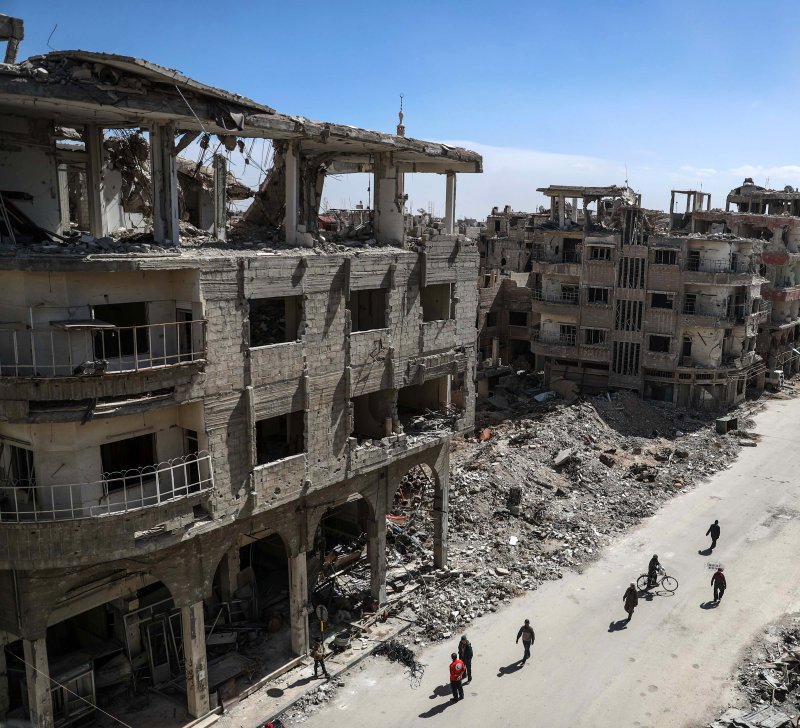A destroyed street in rebel-held Douma, Syria, on Friday. Photo by Mohammed Badra/EPA
TUNIS, Tunisia, March 13 (UPI) -- As the world's great powers tussle for advantage over Syria's battlefields, the Islamic State has receded from the headlines and public consciousness.
Though IS languishes in isolated pockets throughout much of Syria's desert hinterlands or within the jails of the Syrian Democratic Forces, the philosophy that fueled its nihilistic ambition thrives. It is ingrained in the central tenets of groups such as al-Qaida-linked Hayat Tahrir al-Sham and Jaysh al-Islam and lies, hidden from cameras, among Turkish militias besieging the Kurdish province of Afrin.
As the carnage and chaos of a rapidly metastasizing conflict extracts its blood price from the people of Idlib and Eastern Ghouta, the appeal of jihadism's certainties to the young and disenfranchised of Syria remains as strong as ever.
However, for IS, denied the terrain and territory that established the group's dominance, the undimmed hatred of the regime and its allies that rage within Idlib and Eastern Ghouta may bring only a limited advantage.
There are thought to be 6,000-11,000 active IS fighters in Syria. Hundreds more are in crowded prisons of the U.S.-allied Kurds. Others, considered by the Kurds to pose no imminent threat, returned to their villages. The fate of thousands of foreign fighters who flocked to Syria to wage holy war remains a source of international dispute.
For the captured international IS fighters, nothing is certain.
Russia has indicated it may repatriate its fighters but many other countries are refusing.
The legal issues are overwhelming. As the Washington Post reported in January, many countries, including the United States, are proving reluctant to repatriate IS fighters without evidence to prosecute them, something intensely difficult to collect during battlefield captures.
Like so much of what remains in IS's wake, confusion appears to be the dominant factor and, within Syria, it is this that will help what remains of the group.
"I think Syria's chaos definitely helps ISIS," Colin Clarke, a political scientist at the RAND Corp., said in emailed comments. "With so many shifting alliances and groups fighting on the ground, there is little agreement between states and non-state actors that ISIS is the number one priority."
The weakness of the Syrian state plays a role in creating a vacuum where IS could possibly recover. "Because the Syrian regime can't project force into all of the areas of its territory, ISIS will seek these places out, rest/rearm/recuperate and seek to persist until they are strong enough to launch further strikes," Clarke said.
IS's core attraction was always its state-building activities. Other groups were satisfied in aiding the long march to the destined caliphate but IS established a caliphate in Syria and Iraq.
Denied physical control of the towns, cities and services whose existence stood as proof of its divine mandate, IS can continue to occupy territory but its ability to inspire is uncertain.
"ISIS enjoys very little popular support in the areas they still occupy," Clarke said. It is "no longer providing the services of a state, as [it] once did during the apex of their caliphate and, furthermore, any popular support they still enjoy is likely more a result of hatred for the Assad regime than anything else."
Lost within the confusion of Syria, IS remains and its potential threat cannot be dismissed. As David M. Satterfield, the U.S. State Department's acting top Middle East diplomat warned a U.S. Senate hearing in January: "Many of its core leadership and cadre avoided the fight. They remain present and they remain coherent."
This article originally appeared at The Arab Weekly.















